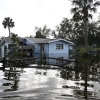David Hester inspects damages of his house after Hurricane Helene made landfall in Horseshoe Beach, Fla., on Saturday.
Chandan Khanna/AFP via Getty Images
hide caption
toggle caption
Chandan Khanna/AFP via Getty Images
Rescue teams across the southeastern U.S. and southern Appalachia scrambled to respond to the destruction caused by Hurricane Helene, as more than 3 million homes and businesses were without any power Saturday amid a continued threat of floods.
Moody’s Analytics said Friday it expects $15 billion to $26 billion in property damage from the hurricane, which by late Friday had been downgraded to a tropical storm.
At least 52 people were killed in five states, including Florida, Georgia, North Carolina, South Carolina and Virginia, the Associated Press reported. The dead included three firefighters, a mother and her 1-month-old twins and an 89-year-old woman who was struck by a tree that hit her house.
The White House said it had approved emergency declaration requests from the governors of Alabama, Florida, Georgia, North Carolina and South Carolina, giving the Federal Emergency Management Agency, or FEMA, authorization to provide emergency response assistance. Some 1,500 federal disaster response personnel had also been deployed to the region.
In Florida, beaches along the coast near Tampa remained off limits as rescue and recovery operations continued. NPR member station WUSF reporter Stephanie Colombini spoke to some residents who ignored restrictions. Andrew Swan, who lives in a house near the beach, told Colombini he rode out the storm alone, with waters rising up to his chest.

“I mean everybody is just kind of in shock and just trying to pick up the pieces. I mean nobody really expected it like this,” Swan said. As the waters rose, Swan said he slept on a kitchen counter with his legs draped over his stove.

A barn and Christmas trees are seen with high water in Ashe County near West Jefferson, N.C., on Friday.
Melissa Sue Gerrits/Getty Images
hide caption
toggle caption
Melissa Sue Gerrits/Getty Images
In North Carolina, Helene produced unusually heavy winds — up to 140 mph — on land, the strongest observed in coastal North Carolina since the start of modern meteorological recordkeeping in the 19th century.
Experts said they were most worried about the flow of debris that was yet to come.
“To me, the biggest concerns around here are debris flows, which are very wet, very fast moving and can travel long distances,” Brad Johnson, who studies landslides and erosion at Davidson College, told NPR member station WUNC.

Johnson added that the debris flows can travel over a mile, carrying rocks, trees and other hazards.
Heavy rains from Helene set a record in Atlanta, which received its highest 48-hour rainfall on record over the past two days. The Georgia Climate Office tweeted on Friday that the area has already seen 11.12 inches of rain, beating a previous record of 9.59 set in 1886. Recordkeeping started in 1878.
In North Carolina, the rainfall totals Friday afternoon were staggering: 29.58 inches for Busick, N.C.; 24.20 for nearby Mount Mitchell State Park; about 13 inches in Boone, some 55 miles away.
The storm dumped more than 8 inches of rain in Wilmington and wrought serious damage to coastal homes and small buildings, as well as agricultural fields.

